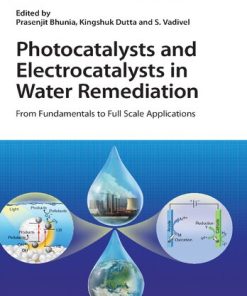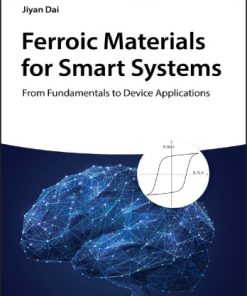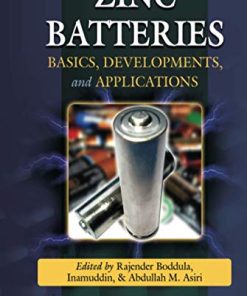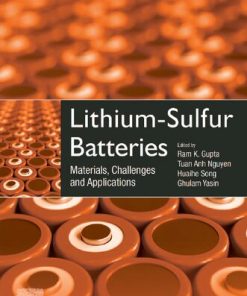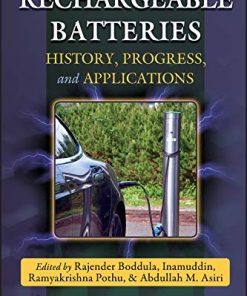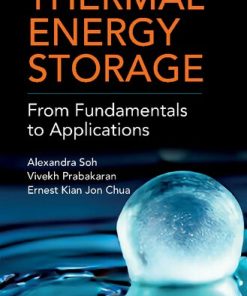Flow Batteries From Fundamentals to Applications 1st edition by Christina Roth 3527832774 9783527832774
$50.00 Original price was: $50.00.$25.00Current price is: $25.00.
Flow Batteries: From Fundamentals to Applications 1st edition by Christina Roth – Ebook PDF Instant Download/DeliveryISBN: 3527832774, 9783527832774
Full download Flow Batteries: From Fundamentals to Applications 1st edition after payment.
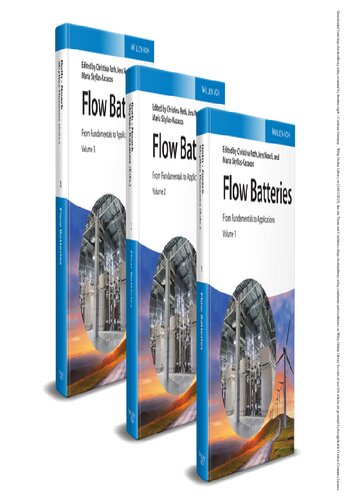
Product details:
ISBN-10 : 3527832774
ISBN-13 : 9783527832774
Author : Christina Roth
From basics to commercial applications, Flow Batteries covers the main aspects and recent developments of (Redox) Flow Batteries, from the electrochemical fundamentals and the materials used to their characterization and technical application. Edited by a team of leading experts, including the “founding mother of vanadium flow battery technology” Maria Skyllas-Kazacos, the full scope of this revolutionary technology is detailed, including chemistries other than vanadium and organic flow batteries.
Flow Batteries: From Fundamentals to Applications 1st Table of contents:
Part I: Fundamentals
1 The Need for Stationary Energy Storage
1.1 Power Systems
1.2 The Need for Electricity Storage
1.3 Changes in Electricity Network Operation: Interconnected Systems, Microgrids, and Standalone Systems
1.4 The Parameters for Storage: Short Term, Small Scale to Long Term, Long Duration, and Large‐Scale Storage
1.5 The Need for Longer‐Duration Energy Storage
1.6 Energy Storage Types
1.7 Battery Energy Storage Technologies
1.8 The Deployment of Flow Battery and Energy Storage
1.9 A Future Outlook
References
Notes
2 History of Flow Batteries
2.1 Early Developments (1884–1963)
2.2 Fe/Cr FBs (1974 – mid‐2010s)
2.3 Zinc/Bromine FBs (1977–mid 2010s)
2.4 1977–1981
2.5 Vanadium‐Based Flow Batteries (1980s–2010)
2.6 Regenesys Polysulphide/Bromide Flow Battery (1984–Early 2000s)
2.7 Other Flow‐Battery Chemistries 2000–2020
2.8 Organic Flow Batteries
2.9 Advanced Flow‐Battery Concepts
2.10 Perspective
References
Note
3 General Electrochemical Fundamentals of Batteries
3.1 Introduction
3.2 Thermodynamics
3.3 Kinetics
3.4 Practical Aspects and Consequences
Acknowledgments
References
Note
4 General Aspects and Fundamentals of Flow Batteries
4.1 Introduction
4.2 The Flow Battery
4.3 Main Components of a FB Energy Storage System
4.4 Advantages and Environmental Benefits
4.5 Types of FB
4.6 Fields of Application
4.7 Ideal Characteristics of a FB
4.8 Engineering Aspects of FBs
4.9 Fluid Flow Aspects of FBs
4.10 Typical Figures of Merit
4.11 Conclusions
Acknowledgments
Abbreviations
List of Symbols and Subscripts
Greek Letters
References
Note
5 Redox‐mediated Processes
5.1 Fundamental Theory on Redox‐mediated Processes
5.2 Redox‐mediated Processes: Various Applications for Flow Batteries
5.3 Conclusion
References
6 Membranes for Flow Batteries
6.1 Introduction
6.2 Membrane Characteristics
6.3 Classification of Membranes
6.4 Conclusions
References
7 Standards for Flow Batteries
7.1 Introduction
7.2 A Definition of Flow Batteries
7.3 International Standards for Flow Batteries
7.4 Other National and International Standards, as well as Other Documents
7.5 Chinese National Standards
7.6 Conclusions
Abbreviations
References
Notes
8 Safety Considerations of the Vanadium Flow Battery
8.1 Regulatory Framework
8.2 Thermal Hazards
8.3 Chemical Hazards
8.4 Electrical Hazards
8.5 Other Considerations
8.6 Summary & Outlook
References
9 A Student Workshop in Sustainable Energy Technology: The Principles and Practice of a Rechargeable Flow Battery
9.1 Introduction
9.2 Laboratory Experiment
9.3 Results and Discussion
9.4 Assessment of Hazards
9.5 Teaching Assessment and Learning Outcomes
9.6 Conclusions
Acknowledgments
Appendix: Supplementary Information for Students
9.A Chemicals and Materials for the Soluble Lead Flow Battery
9.B Experimental Procedure
9.C Types of Flow Battery
9.D Components of Cell Voltage
9.E Characteristics of a Flow Battery
9.F The Efficiency of a Flow Battery
9.G Nomenclature
9.H Supplementary Materials for the Instructor
References
Part II: Characterization of Flow Batteries and Materials
10 Characterization Methods in Flow Batteries: A General Overview
10.1 General Overview
Acknowledgments
References
11 Electrochemical Methods
11.1 Fundamental Definitions
11.2 Cyclic Voltammetry
11.3 Electrochemical Impedance Spectroscopy
References
Note
12 Radiography and Tomography
12.1 Working Principle
12.2 Outlook
References
13 Characterization of Carbon Materials
13.1 Introduction
13.2 Structure of Carbon Materials
13.3 X‐ray Powder Diffraction (XRD)
13.4 Surface Chemistry of Carbon Materials
13.5 Functionalization of Carbons
13.6 X‐ray Photoelectron Spectroscopy (XPS)
13.7 Infrared Spectroscopy
13.8 Imaging Techniques
13.9 Surface Area Determination and Porosity
13.10 Conclusion and Perspectives
References
14 Characterization of Membranes for Flow Batteries
14.1 Introduction
14.2 Ex situ Characterization Methods for Membranes
14.3 In situ Characterization Methods for Membranes
14.4 Summary
References
Part III: Modeling and Simulation
15 Quantum Mechanical Modeling of Flow Battery Materials
15.1 Introduction
15.2 Fundamental Concepts of Molecular Quantum Mechanics
15.3 Density Functional Theory
15.4 Computational Electrochemistry at the Atomistic Scale
15.5 Applications to FB Materials
References
16 Mesoscale Modeling and Simulation for Flow Batteries
16.1 Mesoscale Modeling Introduction
16.2 Mesoscale Modeling of Electrochemical Kinetics
16.3 Mesoscale Modeling of Electrified Interfaces: Monte Carlo Methods
16.4 Mesoscale Modeling of Transport: Dissipative Particles Dynamics and Discrete Element Method
16.5 Lattice Boltzmann Method
16.6 Conclusion and Perspectives
References
17 Continuum Modelling and Simulation of Flow Batteries
17.1 Introduction
17.2 An Engineer’s Approach to Cell‐scale Modelling
17.3 Fundamentals of Flow Batteries: A Thermodynamic Perspective
17.4 Multiscale Modelling of Porous Electrodes
17.5 Discussion and Conclusions
References
18 Pore‐scale Modeling of Flow Batteries
List of Symbols
18.1 Introduction
18.2 Microstructure Characterization
18.3 Theory
18.4 Numerical Methods
18.5 Validation of the Numerical Model
18.6 Simulation Study
18.7 Pore‐scale Modeling Examples
18.8 Conclusion
Acknowledgment
References
19 Dynamic Modelling of Vanadium Flow Batteries for System Monitoring and Control
19.1 Dynamic Modelling of VFB
19.2 Battery System Monitoring and Control
Nomenclature
References
20 Techno‐economic Modelling and Evaluation of Flow Batteries
20.1 Introduction
20.2 Goal and Scope Definition of Techno‐economic Assessment
20.3 Methodology of Techno‐economic Modelling
20.4 Data Basis and Quality
20.5 Meta‐analysis of Techno‐economic Modelling and Evaluation Studies
20.6 Conclusions
References
21 Machine Learning for FB Electrolyte Screening
21.1 Introduction
21.2 Data‐Driven Models
21.3 FB Application
21.4 Conclusion and Outlook
Acknowledgement
References
Notes
Part IV: Vanadium Flow Batteries
22 The History of the UNSW All‐Vanadium Flow Battery Development
22.1 Introduction
22.2 Initial Electrolyte Studies at UNSW and First All‐Vanadium Redox Cell Patent
22.3 First Licence
22.4 Low‐Cost Electrolyte Process Breakthrough
22.5 Further Licencing and Early Field Trials and Demonstrations
22.6 Sale of UNSW VFB Patents
22.7 UNSW Vanadium Flow Cell Research Highlights
22.8 Summary
References
23 Vanadium Electrolytes and Related Electrochemical Reactions
23.1 Electrolyte Composition
23.2 Physicochemical Properties of VFB Electrolytes
23.3 Electrochemical Reactions in VFB
23.4 Types of VFB Electrolyte Degradation and Mitigation Strategies
23.5 Electrolyte Production
23.6 Summary
References
Notes
24 Electrodes for Vanadium Flow Batteries (VFBs)
24.1 Introduction
24.2 Electrode Requirements and Materials
24.3 Electrode Kinetics and Mechanism of the VII/VIII and VIV/VV Redox Reactions
24.4 Effects of Electrodes on the Long‐Term Performance of VFBs
24.5 Summary
References
25 Membranes for Vanadium Flow Batteries
25.1 Introduction
25.2 Membranes for Vanadium Flow Battery
25.3 Recent Developments and Future Directions
25.4 Conclusions
Acknowledgment
References
26 Advanced Flowfield Architecture for Vanadium Flow Batteries
26.1 Introduction
26.2 Principles of Reactor Design
26.3 Outlook
References
27 State‐of‐Charge Monitoring for Vanadium Redox Flow Batteries
27.1 Introduction
27.2 SOC Monitoring Based on Electrolyte Properties
27.3 Model‐Based SOC Estimation
27.4 Summary
References
28 Rebalancing/Regeneration of Vanadium Flow Batteries
28.1 Introduction
28.2 Electrolyte Imbalance
28.3 Rebalancing Processes
28.4 Summary
References
29 Life Cycle Analysis of Vanadium Flow Batteries
29.1 Introduction
29.2 The LCA Methodology
29.3 Definition of Boundaries for the VFB
29.4 LCA of VFB
29.5 Comparison with Other Batteries
29.6 Conclusions
References
30 Next‐Generation Vanadium Flow Batteries
30.1 Introduction
30.2 Generation 1 All‐Vanadium Flow Battery
30.3 Generation 2 Vanadium Bromide Flow Battery
30.4 Generation 3 VFB with H2SO4 and HCI Mixed Acid Electrolyte
30.5 Generation 4 Vanadium Oxygen Fuel Cell
30.6 Conclusion
References
31 Asymmetric Vanadium‐based Aqueous Flow Batteries
31.1 Introduction
31.2 V–Fe Flow Battery
31.3 V–H2 Flow Battery
31.4 V–Ce FB
31.5 V–Mn and V–Co FBs
31.6 Summary
References
Part V: Other Important Inorganic Flow Battery Technologies
32 Zn/Br Battery – Early Research and Development
32.1 Introduction
32.2 Exxon‐Zn/Br‐Design at Project Start in 1983
32.3 Design Development at SEA
33 Iron–Chromium Flow Battery
33.1 Characteristics of ICFB
33.2 Fundamental Principles of Operation for ICFB
33.3 Research Status of Key Components in ICFBs
33.4 Other Recent Research Results in ICFBs
33.5 Summary
References
34 An Overview of the Polysulfide/Bromine Flow Battery
34.1 Introduction – Technology Drivers
34.2 Polysulfide/Bromine FB Components
34.3 Summary
Acknowledgments
References
35 Fe/Fe Flow Battery
35.1 Introduction
35.2 The All‐Iron Flow Battery Chemistry
35.3 IFB Background
35.4 IFB Economics
35.5 Hybrid Flow Battery Performance
35.6 Slurry Iron Flow Battery Concept and Performance
35.7 Summary
References
36 Zinc–Cerium and Related Cerium‐Based Flow Batteries: Progress and Challenges
36.1 Introduction
36.2 The Cerium, Positive Electrode Reaction
36.3 Types of Cerium‐Based FBs and Their Performance
36.4 Summary
36.5 Recommendations for Further R&D
References
Note
37 Undivided Copper–Lead Dioxide Flow Battery Based on Soluble Copper and Lead in Aqueous Methanesulphonic Acid
37.1 Introduction
37.2 Experimental Details
37.3 Results and Discussion
37.4 Conclusions
Acknowledgements
References
38 All‐copper Flow Batteries
38.1 All‐copper Flow Batteries (CuFB)
38.2 Chemistry
38.3 Cell Components
38.4 Stack Configuration
38.5 Economy and Sustainability of the Solution
References
39 Hydrogen‐Based Flow Batteries
39.1 Introduction
39.2 Cell Architecture
39.3 Considerations and Governing Phenomena
39.4 Chemistry and Cell Performance
39.5 Concluding Remarks
References
Note
Part VI: Organic Flow Batteries
40 Aqueous Organic Flow Batteries
40.1 Advantages
40.2 Challenges and Opportunities
40.3 Classes of Aqueous Organic Redox Actives
40.4 Properties of Aqueous Organic Redox Actives
40.5 Performance of AOFBs
40.6 Outlook for AOFBs
Acknowledgments
References
41 Metal Coordination Complexes for Flow Batteries
41.1 Introduction
41.2 Aqueous Metal Coordination Complex Based Flow Batteries
41.3 Non‐Aqueous Metal Coordination Complex Based Flow Batteries
41.4 Conclusion
References
42 Organic Redox Flow Batteries: Lithium‐Ion‐based FBs
42.1 Introduction
42.2 Semi‐solid Electroactive Materials for LFBs
42.3 Redox Targeting‐based LFBs
42.4 Challenges and Outlook
References
43 Nonaqueous Metal‐Free Flow Batteries
Preamble
43.1 Introduction
43.2 Catholytes
43.3 Anolytes
43.4 Symmetric and Bipolar Redox Materials
43.5 Limitations and Challenges
References
44 Polymeric Flow Batteries
44.1 Introduction
44.2 Basic Organic Redox Moieties
44.3 Oligomers and Polymers
44.4 Examples of Polymeric FBs
44.5 Countering the Challenges
44.6 Conclusion and Outlook
References
Part VII: Industrial and Commercialization Aspects of Flow Batteries
45 Inverter Interfacing and Grid Behaviour
45.1 Introduction
45.2 The Six‐Switch, Three‐Phase Inverter Circuit
45.3 Inverter Control Modes for Energy Storage Applications
45.4 Conclusions
Reference
46 Flow‐Battery System Topologies and Grid Connection
46.1 Introduction
46.2 Topologies
46.3 Evaluation of the Topologies
46.4 Summary
References
47 Vanadium FBESs installed by Sumitomo Electric Industries, Ltd
47.1 Historical Overview [1–3]47.2 Typical Vanadium FBESs Delivered by Sumitomo Electric
47.3 Summary
References
48 Industrial Applications of Flow Batteries
48.1 Company History: How Funktionswerkstoffe Forschungs und Entwicklung GmbH Became Enerox, and What Is CellCube
48.2 Elephant in the Room: Can Flow Batteries Deliver the Duration They Promise?
48.3 Anatomy of A Project: What Does It Take to Put in a MW‐Plus Battery in the Field?
48.4 I’m on a Boat!: Innovation at CellCube
48.5 Sunny Upside: An Egg Pun or a Realistic Outlook?
Acknowledgements
Reference
Note
49 Applications of VFB in Rongke Power
49.1 Development and Application of Core Materials for VFB
References
50 Metal‐Free Flow Batteries Based on TEMPO
50.1 Introduction
50.2 Properties, Synthetic Procedures, and Redox Reactions
50.3 TEMPO Flow Batteries – Selected Examples
50.4 Raw Materials Outlook and Summary
References
Note
51 Commercialization of All‐Iron Redox Flow‐Battery Systems
51.1 Introduction
51.2 Background
51.3 Key IFB Technology Breakthroughs and IFB System Commercialization
51.4 Conclusions
References
52 Application of Hydrogen–Bromine Flow Batteries: Technical Paper
52.1 Introduction
52.2 Energy Domain
52.3 Power Domain
52.4 Application
52.5 Conclusion
References
53 Some Notes on Zinc/Bromine Flow Batteries
53.1 Modern Large Scale ZB Flow Battery
53.2 Energy Storage Cost
53.3 The Gould/ERC ZBF Battery
53.4 The Gould/ERC ZBF Battery Stack
53.5 The Gould/ERC ZBF Battery Stack Electrolyte System
53.6 The Gould/ERC ZBF Battery Stack Electrolyte Circulation System
53.7 Shunt Currents – Are They for Real?
53.8 Can Battery Efficiency be Over 100% ?!
53.9 Zinc–Bromine Battery Efficiency
53.10 The Solid Bed ZnBr2 Flow Battery
53.11 Flow Battery Auxiliary Power
53.12 Summary
54 Mobile Applications of the ZBB
54.1 Introduction
54.2 Scheme of the Zink–Bromine Battery
54.3 EV‐Application Issues
54.4 Testing of Electric Vehicles
54.5 Summary
People also search for Flow Batteries: From Fundamentals to Applications 1st:
flow battery explained
what is flow battery technology
flow battery companies
flow batteries for cars
flow batteries for home
Tags: Flow Batteries, Fundamentals, Applications, Christina Roth
You may also like…
Medicine
Chemistry - Technical & Industrial Chemistry
Engineering - Energy & Power Resources
Engineering - Industrial Engineering & Materials Science
Lithium-Sulfur Batteries: Materials, Challengess and Applications 1st Edition Gupta R.K.
Engineering - Energy & Power Resources
Rechargeable Batteries: History, Progress, and Applications 1st Edition





